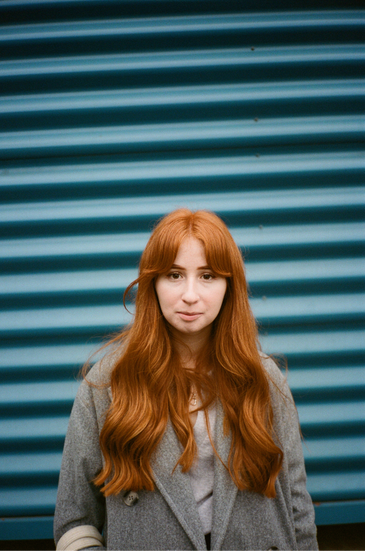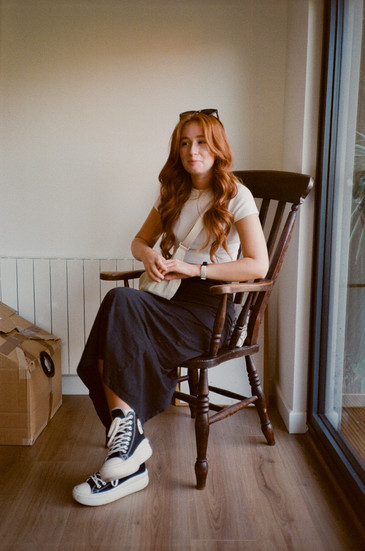For the Loathing of Kodak Portra 400 Film in Compact Cameras
- Max Lamdin

- Feb 20
- 7 min read
Kodak Portra 400 is considered a staple in the film photography community but are people missing a trick with this other option?
Don't get me wrong, I see the appeal of Portra 400 as a great all rounder when it comes to shooting film. It's flatter profile allows for more flexible editing while it does a a fantastic job at retaining colour detail (speicfically skin tones for Portrait photography which is where it's name derives from) as well as being a fast enough speed for a wide range of applications and I've shot a LOT of it over the years, just take a look below to see some of my favourite images captured with it:
Yet I haven't shot a roll of the stuff since February 2022(?!), and there are a few reasons for this reluctance to shoot it which I will get into now.
Colours
For the longest time I really liked the warm tonality that Portra has in spades. It makes skin tones look natural and gives them depth I'm not quite sure how to describe, something which is obviously beneficial. However, this does mean that other areas of the image are hit with the same warm tones universally. Of course the film itself has no way to differentiate between areas containing skin and those not and here lies the problem. Landscape shots of greenary lose their lushness and shadow areas get this weird red/magenta/yellow hue which can make the photos look unnatural (something we probably don't want). This can of course be edited out and removed yet it then alters the colour of any skin tones in the shot. For that reason alone I opted to look for alternatives which don't have such tricky to edit casts. If you go back and look at the above images again, tell me with all honesty that you don't think they're too warm, even when shooting in snow! For a film that prides itself on its ability to be edited and colour corrected to the nth degree why would I keep having this issue?
Production
During 2020 and going into 2021 Kodak was struggling big time to keep up with production, post Covid was a struggle for a lot of manufacturers with people not being able to do the things they were doing pre-Covid but Kodak had a different issue. Post-Covid suddenly there were MORE people wanting to shoot film and Portra 400 in particular was in such high demand that they couldn't make enough of it and it was a genuine struggle to find it in stock anywhere! This issue has now subsided (again, for a number of reasons) thankfully meaning film supplies are significantly better. However, due those times many people had to look for alternative film stocks and some (myself included, but more on that later) found some alternatives we really loved.
Price
I truely believe we are watching Kodak shoot themselves in the foot in slow motion. Year on year there is a price rise, sometimes as little as 5% but can be as much as 20%, meaning a singular roll of Portra 400 can easily be as much as £20-£25 PER ROLL as of writing this post. I've been shooting film for almost 15 years now and I remember the good old days of Agfa Vista 200 in Poundland (it cost £1 per roll) and Kodak Colourplus 200 for £2.99 a roll (it's now £10 a roll). So these price rises do sting a bit. I'm glad film manufacturers have been able to get to this point where they are actually making a profit on film, but when Portra 400 got to £15 a roll around 2 or 3 years ago I thought "that's a good price for a professional film stock", as it differentiated it from the more consumer films on the market and if you wanted that Portra "look" you would still feel comfortable at that price. And then the price went up, and up, and UP! I feel that this descision has ultimately lead to most new film photographers being priced out of this hobby as a roll of film can easily be more expensive than the camera they found at their local charity shop, suddenly it's not a fun little hobby it's an investment. I truely believe this is why many young people are now transitioning over to seeking out older CCD compact cameras (a bad decision in my eyes) as it has a similar "filmic" look without the absorbitant added cost. This is something Kodak should have forseen from their past experiences with sh** digicams and printers, if you price people out of something they will go looking elsewhere.
Therefore, in mid 2020 I looked for alternatives. Firstly, I bought a lot of Fujifilm Pro400H (💀), but that had recently been discontinued in 35mm but at least sasiated my appetite for 120 and resulted in me buy a 100 roll 'pro pack' that I'm running out of (another topic for another time). I carry around a compact camera with me everywhere, admittedly I don't use it as much as I probably should but at least it's with me. I experimented with Kodak ProImage 100, which was somewhat of a rarity in the UK at the time and was pleased with the results.
Colours were lovely and rich, I found it easier to edit that Portra 400 and it was about 30-50% cheaper. Alas, that 100ISO put me off. All the compact cameras I use would want to use the flash, even outdoors on occassion and I was worried about slow shutter speeds so I had the rule it out.
Now, there are limited options when it comes with 400ISO colour films. Even fewer when you discount all those which are limited runs or tricky to get in the UK at an affordable price. So you probably know where this is going but I tried my first roll of Kodak Ultramax 400 and damn it was good!
All of the things which had turned me off of Portra 400 drew me into shooting more Ultramax 400. Colours are punchy and vivid but not overly so with a pleasing amount of saturation and contrast meaning shots don't have to be edited afterwards. Supply was great and not only can you get it in single rolls at about £13-£15 but also triple packs which which brings the price per roll down even more so you're looking at £12-£13 per roll. 400ISO means I have more flexibility to shoot indoors or outdoors with or without flash. I've shot this film on the sunsoaked Croatian and Greek coast as well as dimmly lit resturants and tattoo studios (a little tradition of mine) and it just delivers what I'm looking for. Whenever I think of compact camera shooting it's always with those rich colours and contrast that add to their charm. They don't feel exactly 'true to life' more like a stylised memory but this is what you want from this type of shot, it's about capturing a snapshot and the roughness of the film and cameras is what people strive for. Bare in mind that most of these 80s/90s point and shoot cameras we made for consumers, consumers who wouldn't be editing and just wanted to capture memories and they would be using the cheaper consumer film stocks to do this, and this is exactly why Ultramax 400 was first introduced. It oozes 90s/00s grit and nostalgia which is very much in style and what most people getting into film photography nowadays are expecting.
I have personally recommended Ultramax to hundreds of people over the years. Young, trendy people who have just found or picked up their first film camera and are chomping at the bit to shoot it. All the limited research they've done has told them that Portra 400 is the G.O.A.T film, then they see the price and you can see them recoil in horror, these are mostly struggling students to be fair, and they're isntantly wondering if this is really a hobby they want to persue. That's usually when I step in and say "have you considered Ultramax?" to which they reply "Ultra-what?". On the other side of that, I've seen countless people who have fallen prey to the Portra 400 hype and then be visibly disappointed when they get their flat, unsaturated and surprisingly clean pictures/scans back and they don't understand why they look the way they do, but no one told them that choosing the right film made a difference. This can be incredibly disuading for them as they think it's something they've done wrong, or is it the camera? They were told Portra was the best so why are they unhappy with these pictures? Again, some gentle persuasion to try again with a different film is required and often times it makes all the difference.
Ultimately this is what is required if we are to keep this medium alive. Better education on seemingly trivial topics which most weathered film photographers would scoff at. Choosing the right film can make or break how someone feels about the medium just by how well it delivers on their pre-existing expectation of the final result. More people shooting film is a good thing as it means better availability, more sharable knowledge and a larger consumer base for manufacturers to invest for. These people will also be the driving force for the short and long term future of film photography, and in turn hopefully inspire future generations to pick it up as a hobby. We can't stop the likes of Kodak from digging their own graves but by shifting the market ever so slightly they may one day realise where they and so many others are going wrong.
If you'd like to see more on this topic I have a separate YouTube video discussing this exact topic:
































































Comments